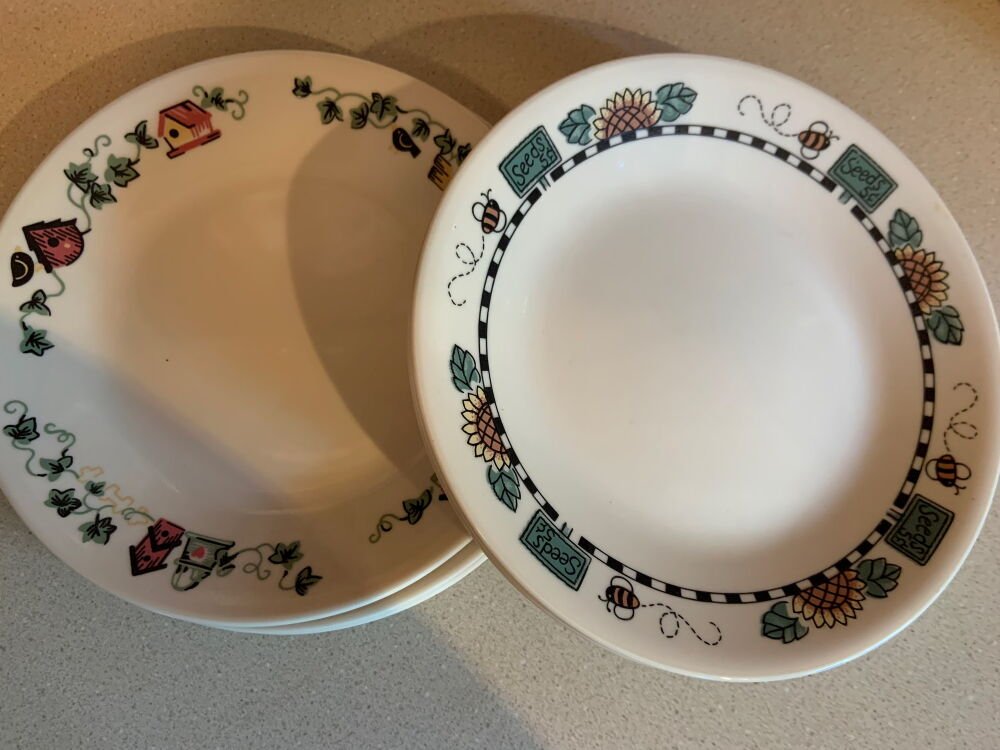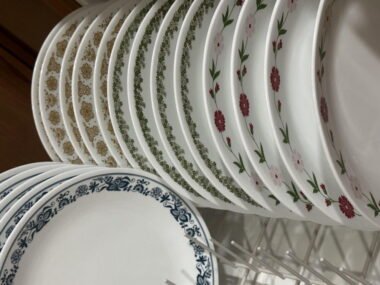Key Points
- Popular Corelle patterns like Winter Frost White and Butterfly Gold have been discontinued since 1970.
- Rarity and condition determine the worth of over 27 discontinued vintage designs, which cost $5 to $450.
- Decorative patterns made before 2005 may contain lead, so use them safely.
Corelle’s sturdy glass tableware has won over collectors and casual users with its creative design for decades. Corelle, founded in 1970 by a pioneering glassmaker, became known for its lightweight, chip-resistant, microwave-safe tableware. Over time, the firm has created several designs that fulfilled regular eating needs and become collectibles. Many of these patterns have been discontinued, producing an interesting mix of nostalgia, beautiful design, and financial possibilities for collectors. This essay will examine the rich history of discontinued Corelle patterns, their design progress, safety issues, and collector suggestions, revealing an everlasting collectible heritage.
Evolution of Corelle Patterns
The early 1970s were a time of minimalist design and dramatic color and pattern innovation for Corelle. The brand changed with preferences and culture throughout the years. Each age produced new design trends that customers loved, making some designs eternal and others fleeting masterpieces.
Early Designs: 1970s
Many Corelle designs from the 1970s generate nostalgia among collectors. Despite its discontinuance, Winter Frost White is a simple, pure white design that remains timeless. Spring Blossom Green and Butterfly Gold show the brand’s diverse styles throughout this era. These designs have delicate flower embellishments and decorative borders that suit many preferences.
Specifics of 1970s patterns include:
- Minimalist Design: Clean lines and delicate details.
- Add vibrant accents with beautiful flower designs and borders.
- Due to their timeless style, many of these designs are still popular.
Transition and Innovation: 1980s
Corelle adopted increasingly colorful and elaborate designs in the 1980s as design tastes changed. Shadow Iris and Spice of Life were contemporary themes with a reference to heritage. Corelle created vivid designs in the 1980s by widening its palette and experimenting with bolder color schemes.
Events in the 1980s included:
- Extended Color Palettes: Bolder, deeper colors.
- Innovative Designs: More elaborate designs that blended contemporary and heritage.
- Wider pattern selection to suit different tastes and home décor trends.
Contemporary Trends: 1990s and Beyond
Corelle designs became increasingly whimsical and creative in the 1990s. Collectors liked Abundance and Rosemarie for their contemporary, nostalgic style. Later patterns retained the brand’s legacy of utilitarian and attractive items, but they were discarded as new designs gained center stage.
Features of 1990s patterns include:
- Modern aesthetics: A mix of modern and traditional.
- Collectionibility: Many patterns are no longer made, making them desirable collectibles.
- Different themes: From fun to classy.
Examining Discontinued Patterns
The following table lists some of the most prominent discontinued Corelle patterns by manufacturing era, along with their descriptions and projected value ranges.
| Pattern Name | Production Years | Description | Estimated Value Range |
|---|---|---|---|
| Winter Frost White | 1970 | Simplistic, plain white design; minimalist aesthetics. | Under $20 (single), $20–$150 (sets) |
| Spring Blossom Green | 1970–1986 | Dark green floral borders on a white base, with occasional solid green flowers. | $5–$20 (single), $50–$200 (sets), up to $450 (rare set) |
| Snowflake Blue | 1970–1976 | Blue snowflakes with connected semicircular trim. | $10–$20 (single), over $150 (sets) |
| Butterfly Gold | 1971–1981 | Broad gold borders featuring delicate flowers and butterflies. | $10–$150 (sets), up to $300 (rare items) |
| Old Town Blue Onion | 1972 | Blue onion floral design accentuating the border. | $5–$10 (single), $40–$150 (sets) |
| April (April Daisy) | 1977–1979 | Bright yellow and white flowers with a yellow rim line. | $10–$50 (small sets), around $150 (48pc set) |
| Indian Summer | 1977–1985 | Autumn-themed with pale yellow and burnt orange accents and a floral center. | Up to $100–$120 (large sets), under $10 (single) |
| Meadow | 1977–1985 | A dense arrangement of colorful flowers with a countryside aesthetic. | $10–$70 (used sets), $100–$150 (new unopened sets) |
| Blue Heather | 1977–1981 | Delicate blue floral motifs reminiscent of heather sprigs. | Under $50–$60 (generally), $170 (38pc set) |
| Woodland Brown | 1978–1985 | Dark brown floral and natural motifs with simple centers. | $10–$50 (generally), up to $80–$90 (large sets) |
| Wildflower (Spring Bouquet) | 1978–1986 | Features large red/orange and yellow flowers with a dynamic center bunch. | $10–$30 (single), up to $150+ (large sets), $250 (dinner set) |
| Batik | 1979–1982 | Deep brown wax-resist-style pattern with floral and foliage accents. | $5–$70 (sets) |
| Dimension IV | 1980–1985 | Includes variants like Citrus, Almond, Cinnamon, Heather, Onyx with single/double borders in diverse hues. | $10–$60 (generally), higher for larger sets |
| Strawberry Sundae | 1980–1984 | Circular design featuring red strawberries and complementary floral details. | $15–$70 (small sets/singles), $80–$150 (large sets) |
| Sedgemoor | 1981 | Dark brown accents with floral motifs along the rim. | $5–$50 (generally), around $35 (6 teacups) |
| Spice of Life | 1981–1987 | Vegetable motifs with red and yellow accents, balancing simplicity and charm. | $10–$60 (varies with set size) |
| Flirtation | 1981–1983 | Combines light blue, bright yellow, and light green elements with playful floral accents. | $10–$30 (small sets), $50–$60 (full dinnerware set) |
| Harvest Home | 1981 | Farm-inspired design featuring wheat, leaves, fruits, and nuts with framed edges. | $10–$40 (plate and drinkware sets) |
| Morning Blue | 1980s | Soft, light blue floral and foliage motifs with a scalloped edge design. | $10–$100 (dinner plate sets, depending on pieces) |
| Sunshine | 1981 | Yellow sunflower design with light green foliage and accent borders. | $5–$50 (sets, depending on pieces) |
| Calico Rose | 1985–1993 | Features light red roses and green scalloped borders with delicate detailing. | $10–$50 (modern), around $80 (20pc dinner set) |
| Farmfresh | 1986 | Fruits and vegetables encircle the rim with vibrant red, green, and blue accents. | $5–$50 (single), $40–$150 (sets) |
| Shadow Iris | 1986–2015 | Purple iris motifs with green accents and elegant white dishes. | $10–$50 (smaller sets), $50–$100 (full sets) |
| Abundance | 1991–2009 | A translucent, wine-style design featuring red and blue berries, fruits, and leaves. | Approximately $180 (for rare 32-piece sets) |
| Callaway Ivy | 1995–2015 | Green ivy borders with a watercolor texture and scalloped edges. | $5–$20 (single), $30–$150 (larger sets) |
| Rosemarie | 1995–2016 | Blush pink tulips accented by dark green leaves and borders. | $10–$50 (based on set size) |
| Pacific Bloom | 1998 | Central red flower design with subtle red, green, and blue accents and rare beige/gold borders. | $20–$40 (small sets), over $50–$60 (large sets) |
This table shows the variety of Corelle’s discontinued patterns and design innovation over the years. This guide helps collectors identify and evaluate their items.
Vintage Pattern Lead Safety
Understanding the health concerns of acquiring old Corelle tableware is important. Pre-2005 patterns may include trace quantities of lead, a common production material. Lead does not impair the aesthetic or collector value of these artifacts, however they should not be used to serve food. You should showcase them as ornamental art.
Safety Tips:
- Vintage Corelle should be displayed, not served.
- Check Production Dates: Make sure food pieces are made after 2005.
- Even ornamental things should be handled carefully to avoid chipping or breaking, which reduces their value.
Maintenance and Collection Tips
Collectors prioritize Corelle item preservation. Proper care is crucial since these artifacts’ worth relies on their condition and rarity. Expert techniques to preserve your Corelle collection:
Verify authenticity
- Check the bottom of pieces for the Corelle logo or marks to ensure authenticity.
- If feasible, get unusual pattern documentation or authenticity certifications.
Assessing Condition
- Regularly check your collection for chips, cracks, and wear.
- Restoration: Avoid abrasive cleaners and procedures that might harm the surface or edges.
Correct Storage and Display
- To avoid abrasion, hand-wash your items using mild detergents.
- Protect things from chipping with cushioned storage.
- Extreme temperatures and humidity can harm your collection, so keep it in a regulated atmosphere.
Participation in Community
- Collector Forums: Join online groups where collectors discuss restoration, market trends, and insights.
- Attend local and national vintage dinnerware shows to learn about market values and repair methods.
Discontinued Corelle Patterns: Value and Legacy
Besides tableware, discontinued Corelle designs capture time, design, and culture. These artworks have emotional, historical, and monetary importance. Owning old Corelle is like preserving personal and social history for many.
Investment Viewpoint
- Certain patterns are scarce today because to limited production runs.
- Market Trends: Pricing can vary greatly, from low for popular designs to high for unique ones.
- As more people identify old Corelle as a collector, well-preserved pieces may gain in value.
Beauty and Decor
- Many discontinued designs are ageless and perfect for modern home décor.
- Versatility: Their classic designs match vintage to contemporary interiors.
- Conversation items: Vintage Corelle items may spark a conversation about their design and history.
Practical Collection Building Methods
New and experienced collectors can enjoy creating a collection of discontinued Corelle patterns as a historical and investment pastime. Some actions to consider:
Research and Documentation
- List Your Finds: Record the manufacturing years, purchase costs, and notable provenance of your patterns.
- Market Research: Check auction sites and market trends to determine values and demand.
Meeting Other Collectors
- Join local or online vintage dinnerware clubs.
- Trade Fairs: Antique exhibits and trade fairs typically include vintage Corelle items.
Maintenance and Display Methods
- Display Areas: Make an area in your house to display your collection.
- Regular Care: Clean and maintain your items regularly to preserve their condition and value.
The Cultural Impact of Corelle Patterns
Discontinued Corelle designs shaped popular culture beyond their functional uses. They are treasured relics because they recall family gatherings, holiday feasts, and shared meals. These patterns mirror social developments, where changing aesthetics and manufacturing technology generate famous design items.
Collecting these patterns is about preserving history, not simply gathering valuables. Each piece conveys a story, linking former generations with modern collectors and showcasing bygone art.
Conclusion
Corelle’s discontinued designs excite collectors and designers. The complex transition from minimalist designs in the 1970s to flamboyant, vivid expressions in subsequent decades shows the company’s innovation and a larger cultural and aesthetic development. Collectors may choose from over 27 antique patterns no longer in production, each with its own charm and investment potential.
Despite its appeal, vintage Corelle tableware must be safe, especially for lead-containing pieces made before 2005. Collectors may enjoy the beauty of these patterns without the health hazards by treating them as ornamental art rather as tableware.
The beginning or expansion of a Corelle collection requires careful study, handling, and community interaction. The legacy of discontinued Corelle pieces gives an intriguing view into a pivotal time in tableware design, whether you’re drawn to early designs’ nostalgia or later patterns’ creative creativity. recognizing this legacy requires recognizing both the aesthetic appeal and the rich historical background that makes each piece significant design history.
FAQ
Why are Corelle designs collectible?
Corelle patterns are rare owing to their distinctive designs, historical relevance, and restricted manufacture. Both casual collectors and professional investors choose patterns that invoke nostalgia and represent design changes over the decades.
Are old Corelle pieces food-safe?
Patterns from before 2005 may contain lead. Instead of serving meals, utilize these historical artifacts as decorations to prevent health hazards.
What can I do to validate my Corelle dinnerware?
Check the pieces’ undersides for Corelle logos or marks. Keeping records and joining collector communities can also prove authenticity.
What affects discontinued Corelle pattern value?
Rarity, quality, set completeness, and collector demand determine the value of discontinued Corelle designs. Perfect pieces with entire sets are more valued.
How should I maintain my Corelle collection?
Avoid abrasive cleaners, hand-wash with gentle detergents, and store things with padding to prevent chipping. Regular examination for damage helps maintain their condition and worth.
Where can I learn about old Corelle patterns?
Online collector forums, antique exhibitions, and networking with other collectors are great methods to learn about market trends.
Corelle’s rich history and broad design legacy enchant collectors worldwide. The journey through discontinued designs celebrates Corelle dinnerware’s eternal beauty and history. The timeless beauty of these designs inspires and delights collectors of all levels.




